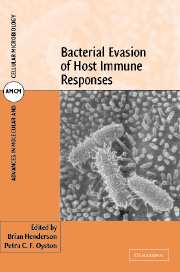Book contents
- Frontmatter
- Contents
- Contributors
- Preface
- Part I Recognition of bacteria
- Part II Evasion of humoral immunity
- 4 Evasion of complement system pathways by bacteria
- 5 Bacterial immunoglobulin-evading mechanisms: Ig-degrading and Ig-binding proteins
- 6 Evasion of antibody responses: Bacterial phase variation
- Part III Evasion of cellular immunity
- Index
- Plate section
- References
4 - Evasion of complement system pathways by bacteria
from Part II - Evasion of humoral immunity
Published online by Cambridge University Press: 13 August 2009
- Frontmatter
- Contents
- Contributors
- Preface
- Part I Recognition of bacteria
- Part II Evasion of humoral immunity
- 4 Evasion of complement system pathways by bacteria
- 5 Bacterial immunoglobulin-evading mechanisms: Ig-degrading and Ig-binding proteins
- 6 Evasion of antibody responses: Bacterial phase variation
- Part III Evasion of cellular immunity
- Index
- Plate section
- References
Summary
INTRODUCTION
Paul Ehrlich, better known for his work on chemotherapeutics, coined the term “complement” in the 1890s to denote the activity in sera that could “complement” the lysis of bacteria induced by specific antibody. By the early 1900s, complement was recognised as composed of two components, and by the 1920s it was believed that at least four serum factors were involved. However, it was not until the 1960s that analytical biochemistry was sufficiently rigorous to allow the identification of the majority of the known complement pathway components. Individual components were named as they were discovered, which accounts for the still confusing nature of the nomenclature for describing the complement pathways (for comprehensive reviews of complement, see Law and Reid, 1995; Fearon, 1998; Crawford and Alper, 2000; Kirschfink, 2001; Walport, 2001a, 2001b).
Three pathways of complement activation have now been described (Fig. 4.1). The classical pathway, first to be discovered, is generally considered to require immune complexes for activation. A second pathway, termed, naturally enough, the alternative pathway, was first proposed by Pillemer in the late 1950s but was not taken seriously until the late 1960s when sufficient evidence had accrued. This pathway is now generally considered to be activated by cell surfaces that are not protected by host-derived complement inhibitors (see Lindahl et al., 2000). A third pathway was elucidated in the late 1980s-early 1990s.
- Type
- Chapter
- Information
- Bacterial Evasion of Host Immune Responses , pp. 55 - 80Publisher: Cambridge University PressPrint publication year: 2003

